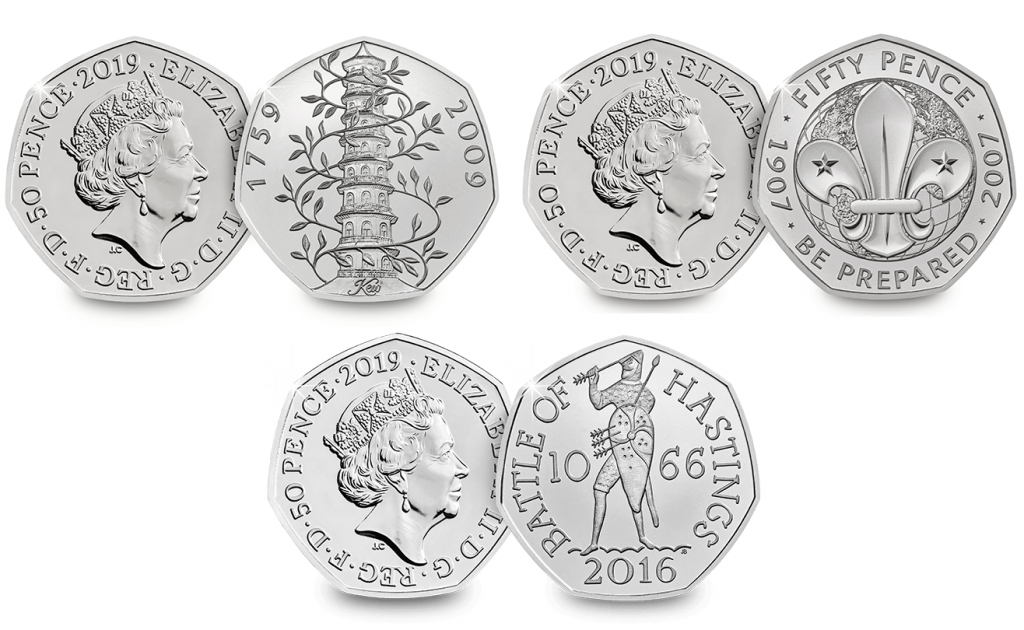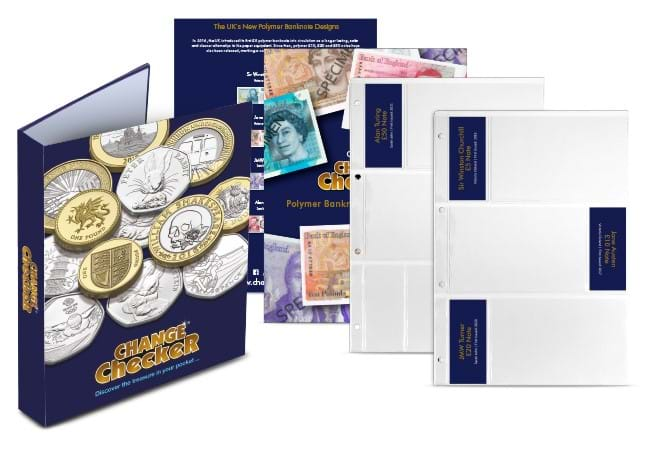Uncategorised
Which Alan Turing £50 notes should you be looking out for?
On the day that would have been Alan Turing’s 109th birthday, The Bank of England have just issued their final banknote in the polymer series, celebrating the famous scientist and mathematician.

The brand new £50 note is full of exciting design and security features, including:
- A photo of Turing from 1951 which is part of the National Portrait Gallery’s collection,
- A design of Turing’s trial model of his famous Automatic Computing Engine (ACE) Pilot Machine,
- Technical drawings for the British Bombe,
- Ticker tape depicting Alan Turing’s birth date (23 June 1912) in binary code, and
- A large see-through window depicting a metallic microchip image with clovers around the outside in dedication to Bletchley Park, where Turing conducted most of his work in WW2.
You can find out more of the exciting features on the UK’s first-ever polymer £50 note here >>
Or, you can watch our video below!
Keen collectors will be eager to hunt down the most sought-after serial numbers for the new note.
When the UK’s first polymer £5 note was released in September 2016, serial numbers became the talk of a nation and stories of early serial numbers selling for thousands of pounds were commonplace.
In fact, an “AK37 007 James Bond Bank of England Polymer £5 note” even sold for £5,000 on eBay – 1,000 times its face value!

But as this brand new £50 enters circulation, which serial numbers should you be looking to get your hands on?
AA01 – the first notes to be printed
AA01 are the first serial numbers to be printed and always prove popular with collectors.
Our eBay Tracker follows the prices of the UK’s Top Coins and Banknotes, including the AA01 polymer £5 and £10 notes, which are currently selling for £10 and £15 respectively. However when the notes were first released we saw a collecting frenzy, with people paying (and demanding) vastly inflated prices for low serial number notes.
Prefixes on the £5 notes started at AA and there are 60 notes on a sheet, AA01- AA60. For each of these cyphers there are 999,000 serial numbers printed: 000001 to 999000. Therefore for the first AA cypher there’s an incredible 59,940,000 notes!
Whilst the £50 note is larger than the £5, meaning less notes will be printed per sheet, there are still A LOT of combinations for AA cyphers on the new £50 – so make sure you keep your eyes out for them!
However, The Bank of England will always hold back some of the notes with the earliest serial numbers, donating them to people or institutions that were involved in the development of the note or who traditionally receive a note when a new series is issued.
For example, Bletchley Post Office was one of the first places to have the new £50 note today, in recognition of the the work done by Mr. Turing and his team at Bletchley Park.
Key dates to look out for
It’s always worth looking out for certain serial numbers matching key dates relating Alan Turing that could become collectable.
For example, 23 061912 represents Turing’s date of birth, whilst 07 061954 relates to his death and 19 121954 would be his birth and death combined.

True Turing fans might also look for 09 071941 representing the date that the enigma code was cracked by Turing and his team at Bletchley Park during WW2.
Novelty numbers and Consecutive notes
There may well also be a rush to find the AK47 serial numbers again and James Bond 007 will likely be popular once more.
Consecutively numbered notes are always interesting to collectors too – one man sold three consecutive AA01 notes for £456!
Q&A
Can you request specific serial numbered notes from the bank?
Sadly not. For the launch of the new £5 note 440 million banknotes were printed and these were printed in very large batches.
To print enough banknotes to service the country’s 48,000 ATMs for example, it’s just not possible for the bank to separate certain serial numbers.
How much should I pay for a new £50 note?
The simple answer is, it’s completely up to you. An early serial numbered £50 note will be a genuine piece of the country’s history. It’s likely The Bank of England will hold an auction of early editions, so if you have the disposable income, why not?!
Will the old paper £50 note still be legal tender?
You will still be able to use the paper £50 note until The Bank of England withdraw it from circulation on 30th September 2022.
Many banks will accept withdrawn notes as deposits from customers. The Post Office may also accept withdrawn notes as a deposit into any bank account you can access at the Post Office. And, you can always exchange withdrawn notes with The Bank of England directly.
Where will I be able to find the new polymer £50 note?
Whilst not all cash points will offer the option to withdraw a £50 note, most banks should be able to provide you with one. It’s worth ringing your local bank in advance to check they have the new note before setting out to collect it.
Will you be looking out for any particular serial numbers? Let us know in the comments below!
Store, Protect, and Present YOUR Polymer Notes with the Polymer Banknote Collecting Pack!
The Change Checker Polymer Banknote Collecting Pack has space to securely house all four of England’s polymer banknotes, including:
- 2016 Sir Winston Churchill £5 Polymer Banknote
- 2017 Jane Austen £10 Polymer Banknote
- 2020 JMW Turner £20 Polymer Banknote
- 2021 Alan Turing £50 Polymer Banknote
Within your collecting pack we’ve also included ID cards for each note, an information page about the new banknotes, and a Change Checker album.
With the release of the final £50 polymer banknote in 2021 and the completion of the Bank of England’s polymer banknote update, now really is the perfect time to start collecting!
The coin we’ve all been waiting for… the 2021 UK Team GB 50p
Back in 2020, collectors were delighted by the announcement of the new Team GB 50p, released as part of the Annual Coin Set, to celebrate Team GB’s participation in the upcoming Olympic Games.
However, due to the coronavirus pandemic and the postponement of the Olympic Games to 2021, this 50p was never individually released in 2020.
Collectors have desperately been waiting for the chance to get their hands on this coin and now the big day has arrived, at Change Checker HQ, we are so excited to be sharing the details of this brand new 50p with you!
The brand new coin, designed by David Knaption, features a depiction of various Olympic sports and the official Team GB logo. But, arguably the most exciting feature of this brand new coin, is that it’s dual-dated!
Unlike the version of this coin issued as part of the 2020 Annual Coin Set, this new coin features a 2021 dated obverse, whilst still keeping the original 2020 reverse design!
Excitingly for collectors, this makes the new 2021 UK Team GB 50p one of only a handful of UK coins to feature a dual-date – adding to it’s collectability!
To secure this coin for your collection for JUST £4.50 (+p&p) in Brilliant Uncirculated quality, presented in Official Change Checker packaging, simply click here >>
Dual-Dated Coins
This brand new 2021 UK Team GB 50p is one of only a handful of UK coins to feature a dual-date.
Other dual-dated 50ps include the 2019 dated Kew Gardens, Battle of Hastings and Scouts 50p coins, issued as part of the 50th anniversary of the 50p collections. These 50p coins featured both their original issue dates on the reverse and their re-issued 2019 dates on the obverse!

Kew Gardens, Top Right: Scouting Centenary, and Bottom: Battle of Hastings.
Additionally, this 50p, which celebrates the UK’s presidency of the European Council of Ministers and the completion of the Single Market features both a 1992 and 1993 date on its reverse!
Undoubtedly, the dual date on this brand new 2021 UK Team GB 50p will add to its collectability, as well as already being one of the biggest numismatic stories of the past year.
And, considering the popularity of previous Olympic 50ps, i’m sure collectors will be quick to snap this coin up for their collections.
Olympic 50p Craze
In 2012, 29 50p coins were released to commemorate the London Olympics and millions rose to the challenge of collecting them all. For many, this marked the start of their interest in coins.
The Royal Mint now estimates that as many as 75% of the Olympic 50p coins have been removed from circulation by collectors, which is a testament to their popularity.

Since then an estimated 75% of these coins have been removed from circulation by collectors adding them to their collection.
And so collectors were delighted in 2016 when The Royal Mint issued a special 50p to wish Team GB success for the Rio 2016 Games. It was considered by many to be the 30th Olympic 50p, so could the brand new Team GB 50p be considered the 31st?

The coin’s obverse features a swimmer with the Team GB logo, the Olympic rings and the inscription ‘TEAM GB’. Designed by Tim Sharp, the coin was officially endorsed by Team GB and celebrates the spirit of British Olympians.
But, now as the 2021 UK Team GB 50p coin takes centre stage, I’m sure the coin collecting community will be sent into a frenzy once more, with demand for this coin already being high.
Fourth Cancellation in Games Entire History
Since the opening of the modern Olympics in 1896, the international sports competition has only been cancelled three times: once during World War I and twice in World War II.

The COVID-19 outbreak is the only non-militant threat to have disrupted the Olympic Games during peacetime.
This 50p marks not only Team GB’s participation in one of the most renowned sporting events worldwide, but also the impact the past year has had on centuries worth of tradition.
With the significance of this year’s Games playing a key part in the interest for this coin, we’re certain coin collectors and sporting fans alike will be eager to add the 2021 UK Team GB 50p to their collections.
Will you be adding this brand new dual-dated 2021 UK Team GB 50p to your collection? Let us know in the comments below!
Secure your 2021 UK Team GB 50p today!
Own the brand new 2021 UK Team GB 50p Coin in superior Brilliant Uncirculated quality for JUST £4.50 (+p&p) and cheer on our incredible athletes as they chase their dreams in Tokyo this summer.
Your coin has been protectively encapsulated in Official Change Checker packaging with that all-important hologram to guarantee its superior quality.
NATIONAL UK £5 FOR £5 BALLOT ANNOUNCED!
This year, Her Majesty Queen Elizabeth II celebrates her 95th Birthday, making her the first ruling monarch in British history to reach this milestone.
In celebration of this very special royal event, The Royal Mint issued a brand new £5 coin, featuring the Royal Cypher and an inscription taken from Her Majesty’s first televised speech.
But Change Checker is incredibly excited to announce that in celebration of Her Majesty’s birthday, we’re launching a NATIONAL EXCLUSIVE UK £5 for £5 Ballot!
We are giving 1,000 lucky collectors the chance of owning the brand new Queen Elizabeth II 95th Birthday £5 for its FACE VALUE of just £5!
It’s completely free to enter, all you need to do is click here >>
The ballot will close on the 25th June and winners will be contacted on the Monday 28th June with details of how to claim this new £5 coin for just £5 – so you must act fast if you want to be in with the chance!
As the Queen reaches this significant birthday, demand for this coin is already high, not just amongst fans of UK royalty coins but for collectors worldwide.
And now, with this Change Checker £5 Ballot NATIONAL EXCLUSIVE, we’d hate for you to miss out!
To sign-up now, for FREE, simply click here >>
The ONLY WAY to own Britain’s new Royal £5 coin for just £5!
Don’t miss out on your chance of owning the 2021 UK Queen Elizabeth II 95th Birthday £5 for its face value – just £5!
The winners will be contacted June 28th, so you must act fast if you want to be in with the chance! Simply click here to sign up >>





